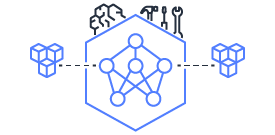Migrating from NxD Core inference examples to NxD Inference#
We have migrated the NeuronX Distributed Core examples/inference
folder to a separate package, NeuronX Distributed (NxD) Inference
(neuronx-distributed-inference), so you can import and use it as a
proper library. This new library, NxD Inference, includes production ready
models that you can deploy out of the box with model inference backends,
such as vLLM. This library also provides modules that you can use to
implement your own models to run with the Neuron SDK.
If you use the inference examples from NxD Core, follow this guide to migrate to NxD Inference. For more information about NxD Inference and to see examples of how to use it, see NxD Inference Features Configuration Guide, NxD Inference Tutorials, and the generation_demo.py script.
Warning
Previous inference examples (including Llama 2, Llama 3, Mixtral, and DBRX) in the NxD Core GitHub repository were removed in Neuron Release 2.23. The models and example code are implemented in the NxD Inference library, so you can easily integrate them with your inference scripts. If you use these examples in NxD Core, we recommend that you update your inference scripts to use the NxD Inference model hub instead. If your use case requires you to directly integrate with the NxD Core library (and not NxD Inference) then you can continue to use the NxD Core library directly. For an example of how to integrate with NxD Core directly, see the newer Llama3.2 1B sample added in Neuron Release 2.23. For more information, see Announcing migration of NxD Core examples from NxD Core repository to NxD Inference repository in next release.
Changes#
1. New config interface#
NxD Inference includes a new model config interface, InferenceConfig,
where NeuronConfig is an attribute within the model config, and the
model config no longer extends HuggingFace’s PretrainedConfig. NxDI
includes an adapter for loading an HuggingFace’s config into this model
config. The configurations are serialized into a file named
neuron_config.json.
This change means that the config structure is inverted compared to the NxD examples folder.
To access the model config (similar to HuggingFace’s PreTrainedConfig), use
config(ormodel.config,self.config).To access the NeuronConfig, use
config.neuron_config(ormodel.neuron_config,self.neuron_config).
To onboard a custom model, you define config classes that extend InferenceConfig and NeuronConfig. The following example from DBRX shows how to define a DBRX-specific NeuronConfig (NeuronDbrxConfig) and InferenceConfig (DbrxInferenceConfig). DbrxInferenceConfig that defines required config attributes and specifies that NeuronDbrxConfig is the NeuronConfig class. The required attributes are typically set by loading a PretrainedConfig (in this case, HuggingFace’s DbrxConfig) into the InferenceConfig. Alternatively, a user can manually provide these attributes to avoid depending on an HuggingFace config class.
class NeuronDbrxConfig(MoENeuronConfig):
def __init__(self, **kwargs):
super().__init__(**kwargs)
self.fused_qkv = True
class DbrxInferenceConfig(InferenceConfig):
def get_required_attributes(self) -> List[str]:
return [
"d_model",
"n_heads",
"max_seq_len",
"emb_pdrop",
"resid_pdrop",
"pad_token_id",
"vocab_size",
"attn_config",
"ffn_config",
]
@classmethod
def get_neuron_config_cls(cls):
return NeuronDbrxConfig
Note
NeuronDbrxConfig extends MoENeuronConfig, which is a subclass of NeuronConfig that includes attributes that are specific to mixture-of-experts (MoE) models.
To load the config from an HuggingFace checkpoint or a compiled
checkpoint, pass load_pretrained_config(path) as the load_config
hook when you create the InferenceConfig.
from neuronx_distributed_inference.utils.hf_adapter import load_pretrained_config
neuron_config = DbrxNeuronConfig() # Provide args
config = DbrxInferenceConfig(
neuron_config,
load_config=load_pretrained_config(model_path),
)
To serialize the config, call save(path).
config.save(compiled_model_path)
To deserialize the config, call load(path).
config = DbrxInferenceConfig.load(compiled_model_path)
NeuronConfig also supports nested configs now. For example, see the OnDeviceSamplingConfig class and its integration into NeuronConfig.
2. New base application interface#
NeuronApplicationBase takes general purpose features from NeuronBaseForCausalLM, such as compile and load, and makes them available in a new abstract base class. You can extend this base class to define other types of application heads, such as for image classification.
3. New generation inference#
The Neuron model classes no longer extend HuggingFace’s PretrainedModel,
so they no longer include a HuggingFace generate() function.
Additionally, GenerationConfig arguments are no longer passed through
the model config. To run HuggingFace generation in NxD Inference, wrap
the Neuron model in a HuggingFaceGenerationAdapter, and pass a
GenerationConfig when you call generate().
from transformers import GenerationConfig
from neuronx_distributed_inference.utils.hf_adapter import HuggingFaceGenerationAdapter
# Init config, model, and tokenizer.
generation_config = GenerationConfig.from_pretrained(model_path)
generation_config_kwargs = {
"do_sample": True,
"top_k": 1,
"pad_token_id": generation_config.eos_token_id,
"max_length": neuron_config.max_length,
}
generation_config.update(**generation_config_kwargs)
inputs = tokenizer(prompts, padding=True, return_tensors="pt")
generation_model = HuggingFaceGenerationAdapter(model)
outputs = generation_model.generate(
inputs.input_ids,
generation_config=generation_config,
attention_mask=inputs.attention_mask,
)
4. New quantization interface#
This new base class also includes an interface for quantization, which
was previously part of the run_llama_quantized.py example in the old
NxD examples folder. The following example saves a quantized checkpoint
for a Llama model. In this example, the config includes a
neuron_config with quantization enabled.
NeuronLlamaForCausalLM.save_quantized_state_dict(model_path, config)
5. Inference demo script (replaces runners)#
In place of runner.py and various run_x.py examples, NxD-I
provides an inference_demo console script. When you run the script,
you provide a model path and configuration parameters to use for
inference. This script includes benchmarking and accuracy checking
features that you can use verify that your models and modules work
correctly.
The following example demonstrates how to run Llama-3-8b with token matching and benchmarking enabled.
inference_demo \
--model-type llama \
--task-type causal-lm \
run \
--model-path /home/ubuntu/model_hf/Llama-3.1-8b/ \
--compiled-model-path /home/ubuntu/traced_model/Llama-3.1-8b/ \
--torch-dtype bfloat16 \
--tp-degree 32 \
--batch-size 2 \
--max-context-length 32 \
--seq-len 64 \
--on-device-sampling \
--enable-bucketing \
--top-k 1 \
--do-sample \
--pad-token-id 2 \
--prompt "I believe the meaning of life is" \
--prompt "The color of the sky is" \
--check-accuracy-mode token-matching \
--benchmark
For additional examples, see the neuronx-distributed-inference
GitHub repository:
aws-neuron/neuronx-distributed-inference.
